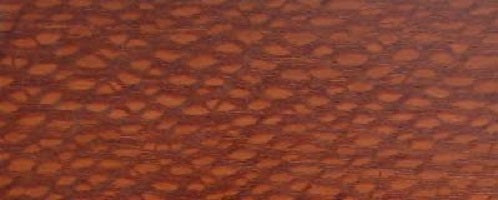
Roupala Lacewood
Roupala Lacewood, also known as Brazilian Lacewood or Leopardwood (Roupala montana, with Roupala brasiliensis as a synonym), is a tropical hardwood from the Proteaceae family, native to Central and South America, ranging from Mexico through Central America to southern Brazil, Bolivia, Argentina, and Paraguay. It grows in a variety of habitats, from rainforests to drier regions, typically reaching 1–8 metres tall, though some trees can grow up to 25 metres with trunk diameters of 1–2 feet, often featuring a shrubby or small tree form due to its morphological variability.
The heartwood of Roupala Lacewood is a medium to dark reddish-brown, sometimes with a pinkish or silvery sheen when freshly cut, though it darkens with age. Its defining feature is the lace-like pattern created by its wide medullary rays, which appear as light brown or grey flecks against the darker background when quartersawn, resembling the spots of a leopard—hence the alternative name Leopardwood. The sapwood is a pale cream to yellowish-white, distinctly separate. The grain is usually straight but can be interlocked, with a fairly coarse and uneven texture due to the contrast between the dense wood tissue and the softer rays, and a moderate natural lustre that polishes to a high gloss.
Roupala Lacewood has a density of around 750–885 kg/m³, making it a moderately hard and heavy wood, denser than many other woods commonly sold as “lacewood” like Cardwellia sublimis (Australian Lacewood), but lighter than true Leopardwood (Panopsis rubescens), which shares similar figuring but is darker and heavier. It’s rated as non-durable, with poor resistance to decay and insect attack, making it best suited for indoor applications unless treated. The wood works relatively well, taking glues, stains, and finishes effectively, though its coarse texture and large ray flecks can cause tearout during planing, requiring sharp tools to avoid issues. Some report it machines, moulds, and polishes easily, achieving a lustrous finish, but its dust can cause eye and skin irritation in sensitive individuals, as noted with other Proteaceae species.
When worked, Roupala Lacewood has no characteristic scent, though its dust can be an allergen, as mentioned earlier. In the UK, it’s often used for decorative purposes, such as veneer, cabinetry, fine furniture, and small turned objects like pen blanks or knife handles, where its striking lace pattern can be showcased—available through suppliers like Why-Aye Wood for £8.48 per 5-pack of pen blanks as of early 2025. It’s also popular for musical instruments like guitar tops, where its figuring adds visual flair, and for carvings, as its grain can mimic patterns like fish scales when paired with softer woods like lime for details. Historically, it’s been used for fuelwood, high-quality charcoal, and medicinally in Venezuela, even as an aphrodisiac in Trinidad and Tobago.
Roupala Lacewood is moderately priced for an imported exotic wood, though its cost varies depending on availability and the quality of the figuring. It’s not listed on CITES Appendices, and Roupala montana is not considered threatened by the IUCN, reflecting its wide distribution. However, its similarity to other “lacewoods” like Panopsis spp. or Grevillea robusta can lead to confusion in the market, as the term “lacewood” is often used loosely for any wood with a similar flecked pattern. In the UK, it’s a popular choice for bespoke projects where its unique aesthetic can shine, often sourced from reputable timber merchants to ensure sustainability.
